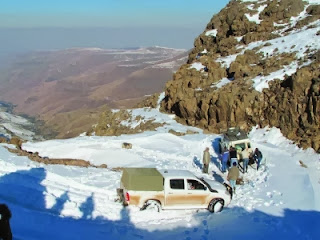All of them aim to
transfer to the wheel that is not slipping, and from the wheel’s perspective,
there are four types of all wheel drive (AWD) systems:
 |
| The Subaru Forester's AWD system provides the best of all worlds. |
• Full-time AWD — for dirt roads and
bakkies or SUVs carrying loads.
• Automatic AWD — for driving icy
roads and mud in winter and economic driving in summer.
Part-time
all-wheel drive
Most
real offroad vehicles have part-time all- wheel drive systems, and typically
enhance the system with a low range gear and locks on
front wheels. When faced
with slippery obstacles, the driver locks both axles using a lever or a button
so that they rotate at the same speed.
 |
| The Land Rover can force all its wheels to pull together by locking the front and back shaft together. |
There is no centre
differential, which means the front wheels cannot turn faster than the rear
wheels. This vehicle can only turn if the wheels can spin. Turning on gravel or
wet tar will cause transmission wind-up and can snap the drive shaft.
When to use: On mud,
snow, ice, sand, for short periods, and at low speeds.
Examples: Jeep
Wrangler, Land Rover Defender, Toyota Land Cruiser.
Full-time
all-wheel drive
 |
| The quattro that started the AWD craze with a mechanical Torsen system that meshed gears into each other. |
Vehicles that have full-time
all-wheel drive have a centre differential that allows the wheels to move at
different speeds to enable turning on any surface. This type of all-wheel drive
can be used both on and off road.
When wheel slip occurs
so that one driveshaft rotates faster than the other, a Torsen differential,
viscous coupling, multi-plate hydraulic clutch, or similar traction device locks
the centre differential to transfer the torque from the axle that slips to the
axle that has traction. As soon as the wheel slip is eliminated, the device
unlocks.
In very slippery
conditions the driver can lock the centre differential manually or automatically
to create a part-time all-wheel drive when the front and rear driveshafts rotate
at the same speed.
Examples: Audi’s
quattro, BMW X-drive, Volkswagen’s 4Motion (and older Synchro) Volvo
X-trail.
Automatic
all-wheel drive
 |
| Modern rally cars use automatic on demand 4WD. |
Because of economic efficiencies,
automatic all-wheel drive systems are most used in modern cars. They are sold
either as AWD, on-demand 4WD, or Electronic Differential Lock (EDL).
Vehicles with
automatic AWD normally pull only with the front axle to save fuel and wear. When
wheel slipping occurs, a multi-plate hydraulic clutch, viscous coupling, or
electronic differential lock engages the rear axle to start pushing with the
rear wheels. Electronic traction control systems also brake the slipping wheels
to lock up the axle and transfer torque almost instantly to the wheels that have
traction.
As soon as the front
and rear axle turn at the same speed the power goes back to the front.
The computers that
activate the system react when a wheel has spun through only a 20% rotation,
although some react even before wheels start to slip, based on the information
from different sensors, including a g-force sensor and accelerator pedal
position.
Automatic AWD performs
well on slippery roads, but these systems require three wheels to have traction
and are stumped when both axles lose grip, as often occurs in off-road
conditions. If the vehicle does not have a locking centre differential, the
driver will be stuck.
Some automatic
all-wheel drives allow the driver to lock the multi-plate hydraulic clutch
manually to give the best characteristics of both electronic and full-time
AWD.
Examples: Nissan
X-Trail, Renault Duster, Subaru Forester.
Selectable
all-wheel drive
This
system allows the driver to choose between the 2WD mode, 4WD mode with automatic
distribution of torque via viscous coupling (acts like the full-time all-wheel
drive ), 4WD with locked differential (acts like the part-time all-wheel drive)
and 4WD with low gearing (low range part-time all-wheel drive).
Examples: Iveco 4x4,
Mitsubishi Pajero’s Super Select transmission, Jeep Grand Cherokee’s SelecTrac,
Toyota Prado.
Subaru’s automatic all-wheel drive system gives the best
characteristics of both electronic and full-time AWD in models like the
Forester.
When stuck in sand
With a front-wheel drive
A light, front-wheel drive half-ton bakkie or hatchback is excellent in mud. Keep the revs up, the gears in second and let the tyres pull the vehicle out of the sludge.
With a rear-wheel drive
All one-ton single cab bakkies are rear-wheel drive, and without at least a rear differential lock they are guaranteed to get stuck in thick mud. Avoid driving them in mud.
With a 4x4 drive train
With enough torque at low revs, vehicles that have all four wheels pulling will idle through thick mud. Use the thinnest tyres possible to help cut through the mud and avoid loads. Keeping the wheels just turning to avoid slipping and sliding. On older vehicles, the axles may have to be joined with a manual difflock to avoid all the power going to the wheel with the least resistance.
With All-Wheel Drive (AWD)
Most sport utility vehicles have all-wheel drive systems, which is either a mechanical or friction-based system that join the two axles when they spin at certain speeds to transfer power between the wheels. The system is designed for slow driving on hard, slippery surfaces like ice or snow, but can be deployed in mud if the road clearance are high enough. Many an AWD sport utility has hung itself on a middelmannetjie.
what about mud?
